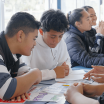Design options for building knowledge
Representation guideline
On this page:
On this page:
Current page section: Design options for building knowledge
Go to top of current page: Design options for building knowledge
Go to top of current page: Design options for building knowledge
Go to top of current page: Design options for building knowledge
Why this matters
Why this matters
Learners differ in their prior knowledge, ways of thinking, and approaches to building knowledge.
By incorporating multiple representations and scaffolded supports, educators can ensure all learners have access to meaningful ways to build knowledge (CAST, 2024).
Design options for building knowledge prompts us to consider learner variability at the outset and offer options to:
This guideline also reminds us to consider:
- How will these options support learners in reaching their goals?
- Could any of these options create barriers or unnecessary challenges?
- Will all learners have fair and equal access to high-quality choices?
- How do these options reflect and respond to learner variability?
Connect prior knowledge to new learning
Connect prior knowledge to new learning
Information is easier to understand when it connects to prior knowledge.
Barriers arise when background knowledge is missing or not recognised as relevant (CAST, 2024).
Highlight and explore patterns, critical features, big ideas, and relationships
Highlight and explore patterns, critical features, big ideas, and relationships
Provide a range of explicit cues or prompts and highlight previously learned skills (CAST, 2024).
Cultivate multiple ways of knowing and making meaning
Cultivate multiple ways of knowing and making meaning
Provide multiple ways to make meaning, supported by models, scaffolds, and feedback (CAST, 2024).
Give learners chances to practice different strategies so they can apply them independently when needed:
- Introduce learners to different ways cultures and communities build and share knowledge in Aotearoa and the wider Pacific region (wānanga, talanoa, storytelling).
- Use clear, step-by-step prompts to help learners build knowledge sequentially.
- Offer different tools (for example, tables, algorithms) to support making connections between information.
- Use interactive models that support exploration and deeper understanding.
- Provide multiple entry points and flexible learning pathways through content (for example, through drama, literature, film, or media).
- Break information into manageable chunks to reduce cognitive overload.
- Release information gradually (for example, with sequential highlighting) to support focus.
Maximise transfer and generalisation
Maximise transfer and generalisation
Learners vary in the amount of scaffolding they need to transfer their prior learning to new ideas, concepts and contexts (CAST, 2024).
- Checklists, organisers, sticky notes, and electronic reminders.
- Mnemonic strategies, visual imagery, or paraphrasing strategies.
- Explicit opportunities for the review and practice of new concepts or skills, including social skills.
- Templates, graphic organisers, and concept maps to support note-taking.
- Scaffolds that connect new information to prior knowledge (for example, word webs, half-full concept maps).
- Embed new ideas in familiar ideas and contexts (for example, use of analogy, metaphor, drama, music, film, etc).
- Generalise learning to new situations (for example, using algebra to calculate the cost of materials for a new school bench).
- Regularly revisit key ideas and linkages between ideas.
Source: Maximise transfer and generalisation: UDL Guidelines 3.0 | CAST (2024) (opens in a new tab/window)
Useful resources
Useful resources

Design options for building knowledge (UDL Guideline)
This UDL guideline helps educators support learners to recognise and manage emotions and behaviours, and empathise with others. As learners will vary in their emotional capacity, offering a range of support options is recommended.
This guideline supports the UDL Engagement principle.
Publisher: CAST (2024)
Next steps
More suggestions for implementing the strategy “Design multiple means of Representation”:
-
Current page Design options for building knowledge
Return to the guide “Universal Design for Learning”

How to use this site
Guide to Index of the guide: Universal Design for Learning
Understand:
- Why UDL is valuable
-
Find out about UDLShow suggestions for Find out about UDL
Strategies for action:
-
Design multiple means of EngagementShow suggestions for Design multiple means of Engagement
-
Design multiple means of RepresentationShow suggestions for Design multiple means of Representation
- Design options for perception
- Design options for language and symbols
- Design options for building knowledge
-
Design multiple means of Action and ExpressionShow suggestions for Design multiple means of Action and Expression
-
How to plan using UDLShow suggestions for How to plan using UDL
-
Design considerations in primary settingsShow suggestions for Design considerations in primary settings
-
Design considerations in secondary settingsShow suggestions for Design considerations in secondary settings
-
Design considerations in NCEA assessmentsShow suggestions for Design considerations in NCEA assessments


